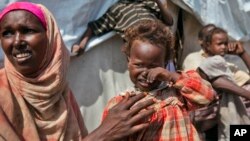Humanitarian aid groups are getting better at predicting food insecurity through the use of early warnings systems. But despite months of alarm-ringing ahead of catastrophe, the response is often too little, too late.
According to the United Nations, more than 260,000 people were killed as a result of the famine that struck areas of Somalia in July 2011.
Valerie Guarnieri, the regional director for the United Nations World Food Program, told VOA that while the warnings were issued months in advance, the response was not enough to avoid catastrophe.
“In Somalia, the sense was that while there was some alarm bell ringing that was happening earlier in the year -- from WFP among them -- that the alarm wasn't sounded loud enough and clearly enough to facilitate that kind of response. So the response only came after the famine was declared and that's really unconscionable, it's just too late," she explained.
Fundraising, media attention
A report released by Oxfam and Save the Children in 2012, after the Somalia crisis had subsided, said one reason for the slow response was that raising money for humanitarian efforts too often depends on media and public attention to a crisis.
The evidence for that is in the data. Figures provided by the United Nations show that donors contributed $342 million to the Somalia appeal in July and August of 2011 -- after the famine was declared -- which is more than the total funding received during the first half of the year.
In the past, it could take up to three months to convert funding into food Guarnieri says, but with new planning techniques, the U.N. has sped that process up to two weeks.
Still, she says, one of the problems is that donors want to see their money in action -- like food dropped from an airplane -- but by that point the crisis is already in full swing and it is sometimes hard to convince them to support contingency plans instead.
“There's an understanding that a pledge made as a forecast allows us to move faster. But there's also always a desire when you make a contribution to then, after your contribution, see that tangible assistance be delivered on the ground," she noted. "So we're trying to address what are seen as some donor visibility issues.”
Unexpected indicators
Early warning systems take into account some of the expected indicators of crisis: malnutrition, harvests, food availability. But the U.N. is also working on better predicting political problems to give agencies a jump on potential emergencies.
Guarnieri says political mapping is “more art than science” at this point, but that agencies are using the system to plan for Burundi, where political tensions have been on the rise ahead of elections in June.
“We've been working as the U.N. in supporting the country team to develop a contingency plan for Burundi in the event that the upcoming elections result in displacement or conflict beyond just a sporadic incident," she explained. "We're working with government as well on that plan and there's going to be a simulation in the coming weeks where we come to test some of the assumptions of the plan to see how ready we are.”
Despite lessons learned from past emergencies, contingency planning and funding still remains a huge challenge.
The most recent data shows that in South Sudan, for instance, where agencies have been warning of the possibility of famine for months, a U.N. humanitarian appeal for $1.8 billion has received less than eight percent of the requested funding.













